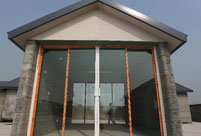 Cherry blossoms reach peak bloom in Washington D.C.
Cherry blossoms reach peak bloom in Washington D.C.
 Top Chinese fashion icons in foreigners' eyes
Top Chinese fashion icons in foreigners' eyes
 Asia's largest business aviation exhibition to be held in Shanghai
Asia's largest business aviation exhibition to be held in Shanghai
 World's top-rated luxury hotels
World's top-rated luxury hotels
 Wu Jing, Xie Nan to hold wedding on May
Wu Jing, Xie Nan to hold wedding on May
 London Cake International attracts tourists
London Cake International attracts tourists
 Let's dance in harmonic Shaanxi
Let's dance in harmonic Shaanxi
 Christie's to auction dazzling diamonds
Christie's to auction dazzling diamonds
 'Model husband' shatters image of love
'Model husband' shatters image of love
 Can animals smile? Or put on a happy face
Can animals smile? Or put on a happy face
BEIJING, April 16 -- China's economy outpaced market estimates in the first quarter of 2014, but economists cautioned that downward pressure remains, and targeted measures are needed to ensure growth falls within a proper range.
The nation's gross domestic product (GDP) rose 7.4 percent year on year to 12.82 trillion yuan (2.08 trillion U.S. dollars) in the first quarter, the National Bureau of Statistics (NBS) revealed on Wednesday.
Market estimates had put first-quarter growth at 7.3 percent.
The figures suggest growth in the world's second-largest economy in early 2014 was stable and that the economy was generally in good health, as Chinese authorities promoted reforms, innovation, restructuring and improvement of people's well-being, according to the NBS.
However, the 7.4-percent growth was slow compared to the 7.7-percent growth in the fourth quarter of 2013 and marked the lowest quarterly growth level since the third quarter of 2012. The figure still outperformed the 6.6-percent growth in the first quarter of 2009, when the global financial crisis wreaked havoc.
Economists said the weaker growth suggested heavier downward pressure on the economy, but that the growth rate was still within a reasonable range.
"I predicted the first-quarter GDP growth to be between 7.2 and 7.3 percent. Though slower, I don't think this level of growth is unbearable," said Wang Jun, a senior researcher at the China Center for International Economic Exchanges.
The economic slowdown came with slower investment and industrial output. Other data jointly released with the GDP figures on Wednesday showed industrial output growth slowed to 8.7 percent in the first quarter.
During the same period, fixed asset investment growth gained 17.6 percent and retail sales expanded 12 percent, while the average per capita disposable income of both urban and rural residents grew 8.6 percent year on year.
These figures, alongside a one-percent drop in the nation's exports and imports in the first quarter and slower power consumption growth, made some economists concerned that a slowdown may extend to next quarter. They wondered how the government would respond to secure stable growth that ensures employment.
Rather than a heavy short-term dose of stimulus, the government prefers "mini stimulus" programs with an eye toward medium and long-term development, some of which have already been announced by the Chinese government since March. These include a new urbanization plan and investment projects in public service sectors.
Wang pointed to measures taken by authorities targeting tax reductions and simplification of administrative procedures, as well as their plans to step up railway investment and renovation of shanty towns.
"These measures aim to stabilize growth. I think the economic momentum will increase from the second quarter and there's no need to worry the economy will slide out of control," he said.
Niu Li, an economist at the State Information Center, said that the government is poised to take fine-tuning measures and deepen reforms that are conducive to growth and market confidence, such as reducing taxes and financing costs of companies.
Chinese Premier Li Keqiang said earlier this month that China has the capabilities and confidence to keep its economy functioning within the proper range.
China has set this year's economic growth target at about 7.5 percent, but the government is giving the target less emphasis. Premier Li said that as long as employment is sufficient and there are no major fluctuations, actual GDP growth will be considered to be within the proper range, even if slightly higher or lower than the target.
Statistics showed that urban employment continued to increase, individual income, corporate profits and fiscal revenue registered steady growth, and consumer prices remained stable.
NBS data also showed a total of 2.88 million new jobs were filled by migrant workers in the first quarter, up 1.7 percent year on year.
Chang Jian, chief economist at Barclays, predicted a recovery of the Chinese economy in the second quarter.
"March's new loans and total financing support the view that financing channels remain open to stabilize growth as demand recovers," Chang said.
Data showed China's new yuan-denominated lending came in better than expected, totaling 1.05 trillion yuan in March, up from 644.5 billion yuan in February. First-quarter new yuan loans totaled 3.01 trillion yuan, up 259.2 billion yuan year on year.
The economic slowdown also came amid mild inflation in the first quarter, with the consumer price index, the main gauge of inflation, rising 2.3 percent.
Chang forecast benign inflation to continue in the coming months, which leaves room for the central bank in tooling reserve requirement ratio cuts and even interest rate cuts if growth is disappointing in the second quarter.
 A bite of China II whets the appetite
A bite of China II whets the appetite Chinese frigate completes its 14th escort mission
Chinese frigate completes its 14th escort mission Let's dance in wealthy Shaanxi
Let's dance in wealthy Shaanxi A date with 798: feel the art around you
A date with 798: feel the art around you 3D-printed houses built in Shanghai
3D-printed houses built in Shanghai World largest scale of umbrella dance
World largest scale of umbrella dance Cherry blossoms reach peak bloom in Washington D.C.
Cherry blossoms reach peak bloom in Washington D.C. Red terraced fields in Dongchuan of Yunnan
Red terraced fields in Dongchuan of Yunnan Presentation ceremony of 33rd Hong Kong Film Awards
Presentation ceremony of 33rd Hong Kong Film Awards The backstage of the Fashion Week
The backstage of the Fashion Week College students in Han costumes
College students in Han costumes Postgraduate works as waitress
Postgraduate works as waitress Life in a Lahu village in Yunnan
Life in a Lahu village in Yunnan An orphan’s wedding
An orphan’s wedding Hollywood documentary brings Diaoyu Islands truth to new audience
Hollywood documentary brings Diaoyu Islands truth to new audienceDay|Week|Month